Constantinople is under crusader threat. 12th century
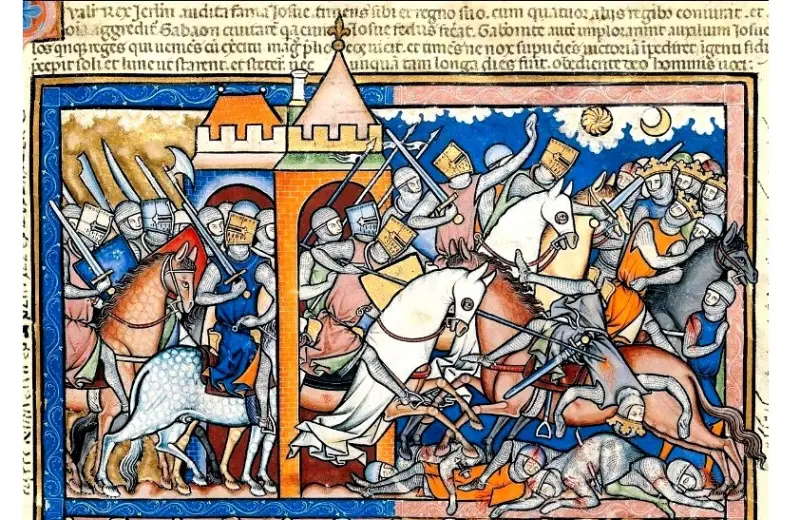
Joshua went to Gilgal. Bible of Cardinal Maciejewski (Louis IX). Morgan Library and Museum. NY. USA
Entry
After a long interval, I return to the topic of the sieges of the “city on a hill” of New Rome. In previous articles, I talked about how many sieges this city has withstood since its creation. But every time a miracle happened?
Or the technical capabilities of the powerful, largest city in Europe were higher than the capabilities of its strong and numerous enemies.
After many vicissitudes associated with the defeat of the Roman army at Manzikert in 1071, which I wrote about in the corresponding article of this series, the Komnenos dynasty came to power in the person of Basileus Alexei.
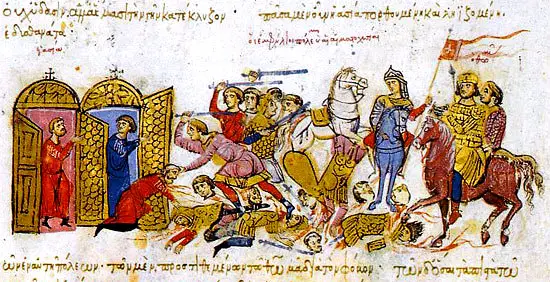
This is what the weapons of the Roman army looked like according to a contemporary of the events, a miniaturist who painted for “Stories Byzantine Emperors": Madrid List. XIII century National Library. Madrid
He found himself in a stalemate; the empire was attacked from two sides by the Turks: the Pechenegs, who in their raids reached the walls of Constantinople, and the Seljuk Turks. The latter practically conquered all of Asia Minor, the breadbasket and main economic territory of the Roman Empire.
In such conditions, the movement that arose in the west of the European continent in defense of Christian values in the East, partly inspired by Alexei Komnenos himself, was salutary for the cause of the Romans in Asia Minor. But...the Western feudal lords would not have been true warriors if they had not tried the stronghold of Constantinople to their teeth: they tried to storm it. Nevertheless, a compromise was found; the common goal of Christian states at this stage prevailed.
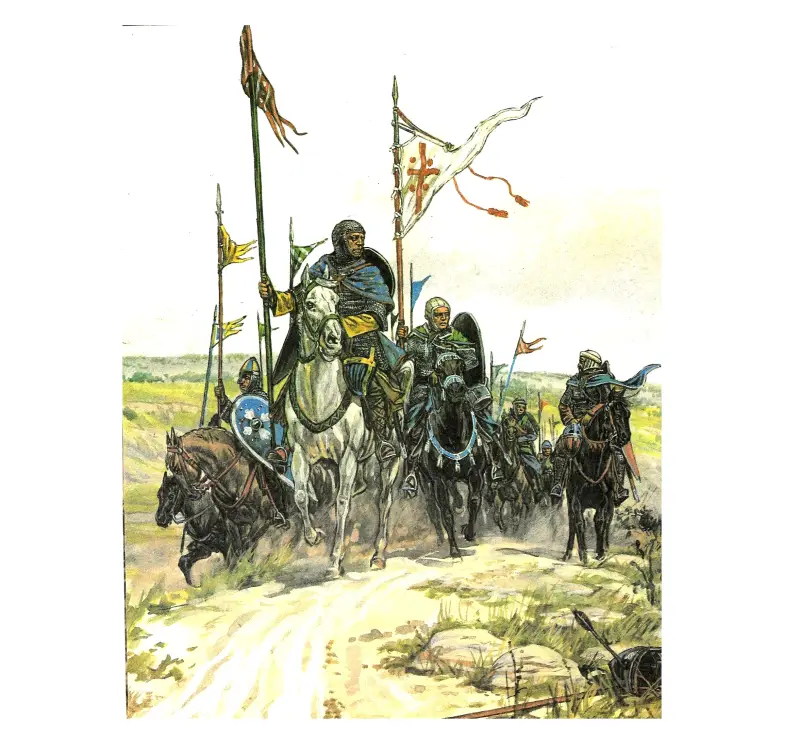
First Crusade. Hood. I. Dzys
During the First Crusade, and following it, Constantinople was able to regain control over the western part of Asia Minor. The empire and army rose from the ashes, and some of the violent Western European states in the Middle East became their vassals. During the reign of the three Komnenos, Alexios, his son Isaac II (1118–1143) and John's son Manuel (1143–1180), the empire expanded and strengthened significantly, but centrifugal tendencies in a huge multi-ethnic country were inevitable.
The defeat of the Crusaders in the East created the need for a new crusade, and in the course of it, a threat to the capital of the empire again arose. This is what we will talk about. Because the path of the Second Crusade in 1147 went through Constantinople.
Reasons for going - choosing the route
Emperor Manuel was not interested in this campaign: the weakness of the crusaders gave him a chance to annex their possessions to his empire or make them his vassals.
The kingdoms were threatened by both Muslim rulers and Byzantium, which believed that its lands should return to the empire. Instead of fighting the “infidels,” there were clashes between Christians, which is why the Turks were able to gather their strength and begin to recapture what they had recently conquered.
In 1144 Edessa was captured. This found a huge response in Europe, but... no one wanted to go on a new crusade. The abbot of the newly founded monastery of Clairvaux, Saint Bernard or St. Bernard, called for the defense of Christian values in the East by the Knight King Louis VII. After the meeting of the new year of 1147, Saint Bernard met the German king Conrad III, the latter also joined the crusading pilgrims.
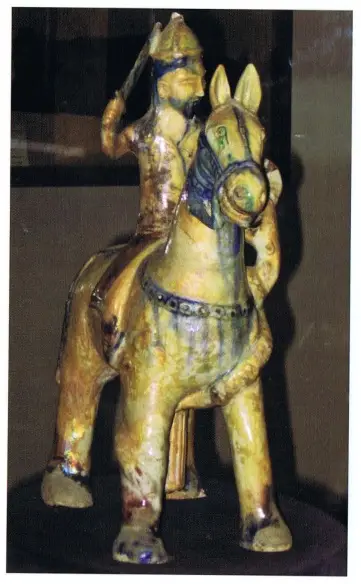
An extremely rare sculpture of a horseman from the Middle East. XII century Al-Raqqa. Museum of History. Damascus. Syria
While Saint Bernard was agitating for a campaign in the Holy Land, local feudal lords, having various “pagans” before their eyes, thought about defeating them and converting them to the true faith.
Thus, the Saxon princes received the right to fight against the pagan Slavs: “conversion or death,” a slogan that became fatal in the crusader movement.
And while the kings of France and Germany were getting ready to go on a campaign, in the spring of 1147, pilgrims from England and Flanders moved by sea to the Holy Land. The storm stopped them in Portugal, where the Bishop of Porto invited them to expel the infidels from Lisbon for Count Alfonso Henry of Portugal. After a four-month struggle, the crusaders took Lisbon in 1148, but they never went to Jerusalem.
Roger of Sicily, an ally of Louis and an enemy of Conrad, joined the campaign in a unique way. He offered his services to transport armies to the Middle East by sea. King Louis was afraid that he would lose part of the army, because everyone could not fit on the ships, and the treacherous Norman would take advantage of this part, using it against the Romans. And Conrad was Roger's enemy and fought with him for control of Italy.
Thus, the land route through the Balkans and Byzantium was chosen. This freed the hands of Roger of Sicily, who was of little interest in the crusade; he was more willing to plunder Byzantium, with which he had extremely strained relations. Firstly, he owned all the former lands of the Romans in Italy, and secondly, he laid claim to Antioch, a vassal state of New Rome. Roger secured his possessions in Italy by concluding an agreement... with African Muslims.
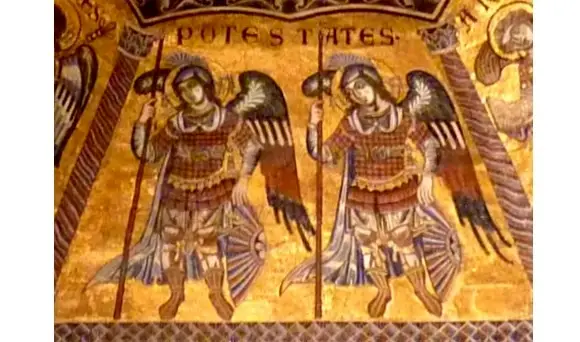
In the Mediterranean, Roman weapons were very popular. Angels in Roman armor. Dome of the Baptistery of St. John. XII–XIII centuries Florence. Italy. Photo by the author
Because of the German troops, the path of all the crusaders had to run through Hungary and Byzantium, with semi-rebellious Bulgaria and Serbia. Thus, a huge army of two kings and gangs of “pilgrims” who joined them were moving towards Constantinople.
The Alemans march towards Constantinople
A large German army left Regensburg. On the border with Hungary, the Byzantine embassy, led by Demetrius Makrimvolit and Alexander, the former ruler of the Italian Ravenna, met King Conrad, inviting him to take the vassal oath in exchange for security and assistance:
The king agreed to take the oath, and the Romans transported his army across the Danube on their ships. In the city of Nais (Nish), the homeland of the founder of Constantinople, they were met by the governor of Dacia (Bulgaria) Mikhail Vrana, who supplied the Germans with food.
The path from the Danube to Sardica went through mountain passes and forests; Marshal Champagne, a participant in the Fourth Crusade, considered this country to be extremely harsh. In Sardika (Sofia) he was met by the governor of Thessalonica, Michael Paleologus.
But after this, the fragile peace was broken, the medieval warriors could not help but succumb to the temptation to plunder. After a difficult journey through the mountains, on the plain they went to great lengths. The Crusaders plundered and burned the outskirts of Philippopolis (Plovdiv), but were unable to capture the heavily fortified city. Tsar Manuel, in order to protect his subjects, sent an army to accompany the pilgrims under the command of Prosukh, a Turk by origin, but raised in Byzantium.
An episode occurred near Adrianople that further aggravated the conflict situation. One sick baron, a relative of the king, stayed in the monastery, but he was attacked, according to various versions, either by Roman soldiers who wanted to profit, or by robbers, and perhaps by the monks themselves. The attackers burned the baron and stole his wealth. For which the commander of the German army, Friedrich of Swabia, the future Barbarossa, plundered the monastery, conducted an investigation and punished those responsible.
In retaliation, he was attacked by Prosukh, who put the Germans to flight. Thus their ardor was moderated, but disagreements intensified.
Natural disagreements
The angry Emperor Manuel sent ambassador Andronikos Opom to Conrad. The ambassador demanded that the Germans immediately, bypassing the capital, cross the Dardanelles to the Asian coast. This did not suit the German king, who wanted to relax in a rich city. Then, taking into account the fact that the desire to “relax” in the capital could be supported by all the forces of the crusaders, Manuel began to prepare the city for defense. He stationed part of the army behind the walls, and part of the cavalry army under the command of Vasily Chikandil and Prosuh in Thrace. So that if the “Celts,” as Byzantine authors called them, attempted to storm Constantinople, attack them from the rear.
The pilgrims camped in Selymbria on the shores of the Sea of Marmara, 67 km from Constantinople. Here, due to a natural disaster, their camp was completely flooded after the rains. Manuel did not take advantage of this situation, but wanted to help his brothers in faith.
But, as Byzantine authors write, Conrad continued to persist; he wanted Emperor Romeev to meet him at the city gates and escort him to the royal palace for negotiations.
Manuel began to strengthen the city. Niketas Choniates (1155–1218) wrote about this:
We will often turn to the work of Niketas Choniates, patrician and logothete of the secret (secret - institution), treasurer of the Byzantine Empire, describing the events of the 12th - early 13th centuries.
For the Romans at this time there was already a triple threat: on the one hand, the German army was under the walls of the capital, and on the other hand, the king of Sicily took the fortress of Kerkyra (Corfu) and began to plunder the Greek coast, on the third, the army of the French crusaders was already heading towards the capital.
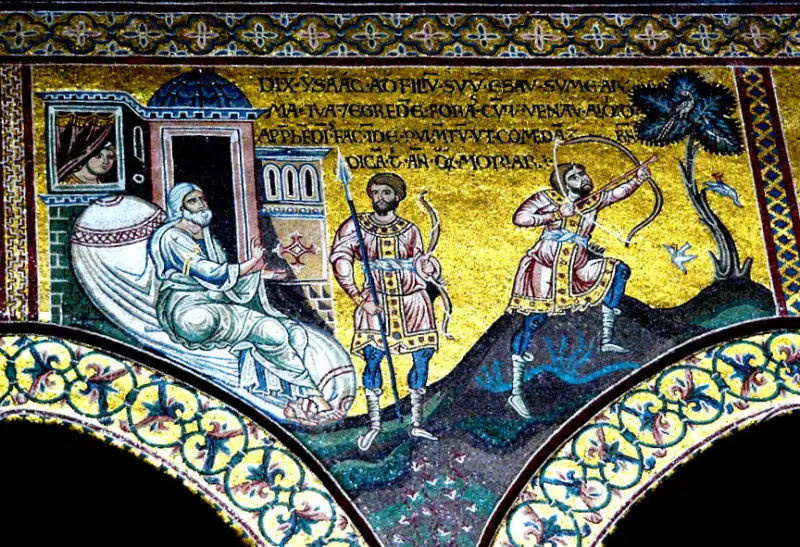
Image of warriors without armor from Sicily. XII century The influence of Byzantium is obvious. Cathedral of the Virgin Mary. 1176–1267 Montreal. Sicily. Photo by the author
Conrad moved his army to the capital, here they found themselves on September 10. The German crusaders, who, as Emperor Manuel assumed, did not particularly obey their emperor, again indulged in plunder. They occupied the beautiful country palace of Philopation near the city walls, opposite the Porta Melantiados or Selimvri gate. And Conrad, having carefully studied the fortifications of the city, realized that it was impossible to take the powerful walls and ditch without proper preparation.
After which he crossed the Justinian or St. Callinicus Bridge at Blachernae, across the Golden Horn Bay, and occupied the Picridion Palace, on the northern side of the Golden Horn, opposite the Phanar Gate (now the Phanar water transport stop). Here the Germans continued their atrocities.
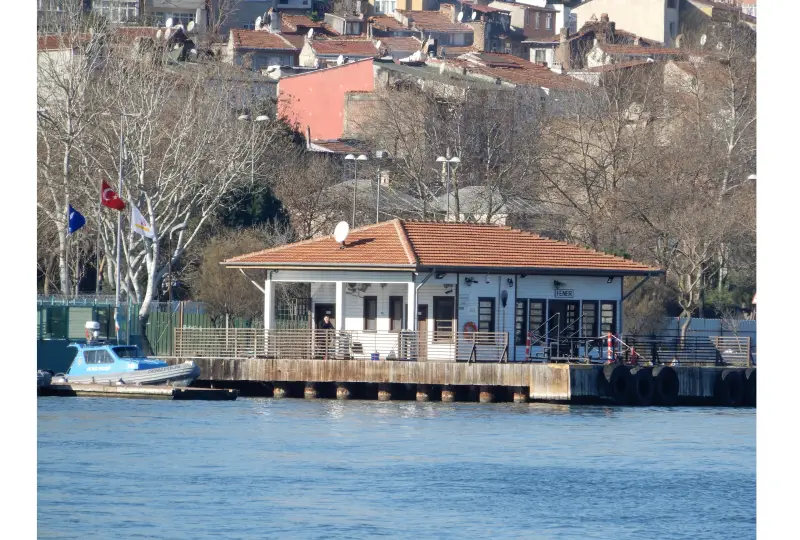
Fanar station. One of the stops of the water tram in the Golden Horn Bay. Istanbul. Photo by the author
Conrad sent envoys to the Roman autocrat. The ambassadors made the following speech:
In response, the basileus joked that he understood everything and now, if anything happens, he will also not restrain the ardor of his people, explaining this by the willfulness of the crowd and the popular impulse.
He again decided to teach the crusaders a lesson by attacking them. His army, according to the emperor’s secretary John Kinnami (1143–1185), although smaller than the hordes of “Alemans,” was more trained and prepared.
The Byzantines lined up in the following order: the Polovtsians, Turks and their own archers-horses were placed in front, behind them light cavalry, then heavily armed cavalry and then, “at the fourth flag,” a combined detachment. The Byzantines attacked the Germans and scattered them. And Basileus Manuel wrote a response to Conrad, where, mocking his first message, he wrote:
The emperor recommended that the king keep the army in check, and he, in turn, demanded a crossing of the Dardanelles, and personally provide him with the royal dromon.
Otherwise, Conrad threatened that he would return home and gather an army to take Constantinople by storm. But they were reconciled by his sister-in-law, Manuel’s wife, Empress Irina, Bertha von Sulzbach. Conrad received gifts and crossed to the eastern shore of the Dardanelles on ships provided by the basileus. His army rested in Chalcedon and moved to Nicaea.
The Franks march on Constantinople
Manuel Vrana, who had met King Conrad at Nis, moved west to meet the French king, who left Saint Denis on 8 June. Pope Eugene III gave him a staff. They met in Regensburg, but the French king evaded his oaths to Basileus Romeev:
The French army was already walking through a devastated land; they were at enmity with both the Greeks and the Germans. But discipline in this army was strictly maintained, and there were no clashes.
The French were moving with a huge convoy, the king’s court was presented in full splendor, Queen Eleanor and her retinue were also traveling with him, they clearly had no idea what awaited them in the war with the Seljuk horsemen. Here is how monk William of Newburgh writes about this morally:
On October 4, they found themselves at Constantinople, the king was met at the city gates by the nobility, and he was received by Emperor Manuel. Odo Diogilsky wrote:
There were some intrigues; the king's brother Robert and the queen were angry that Manuel had made the Count of Antioch his vassal. And the bishop, legate of the pope, Geoffroy of Langres was afraid that, at the request of Emperor Manuel, the pope would replace him with Guido of Florence. Therefore, he pushed King Louis into an alliance with Roger II. Which has already taken Kirkira (Corfu).
But the Franks were especially outraged by the fact that Manuel entered into an alliance with the Iconian Sultan Masud. He harmed the empire for a long time, until the emperor went on a campaign in 1146 and besieged the capital of the Sultanate of Iconium, but withdrew from it in the spring of 1147, without concluding a truce, to which he had now agreed. This peace meant that Manuel would not help the crusaders with military force.
And Roger captured the rich cities of Corinth and Thebes and took silk craftsmen from there.
And as happens in history, on top of that, during a skirmish at the market in Constantinople, a Fleming killed a seller. And although the king punished him, Manuel forbade supplying the Franks.
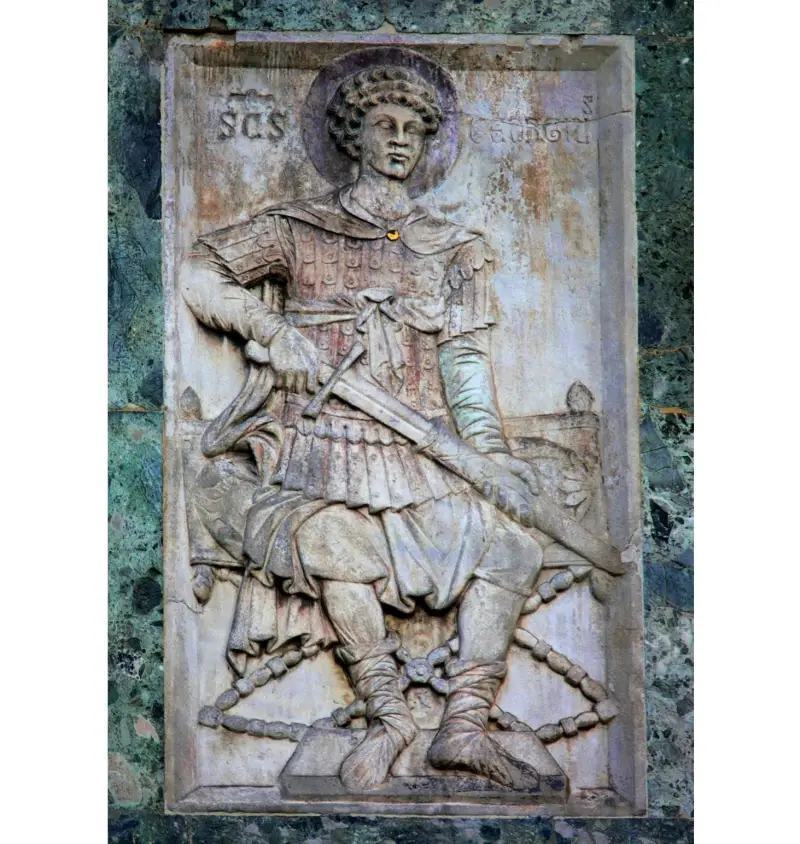
This is what a Byzantine warrior looked like in the 1204th century. An image on the facade of St. Mark's Cathedral, possibly stolen from Constantinople in XNUMX. Venice. Photo by the author
Here Manuel, who himself was raised as a European knight, had to resort to cunning, “Byzantineism.” In order for the French to quickly cross the Bosphorus, he started a rumor about the victories of the Germans. And that if things go like this, then there will be no room left for the French in Asia for exploits. The feudal freemen vying with each other began to swear allegiance and strive to cross the Bosphorus.
And the king guaranteed the return of all the lands of the empire that he would capture on the way to Jerusalem. While the Germans left Nicaea on October 15, they were supplied by the Byzantines, but at Doryllea (modern Eskisehir) they were defeated by the Seljuks.
In Nicaea, the French learned about this; the path to Dorrilea was covered with corpses. A huge French caravan and the remnants of the Germans moved through Pergamon to Ephesus, hoping to pass to the Middle East along the coast. They became an excellent target for nomads. The losses of people, livestock and luggage were enormous. Of the 90 thousand that the Byzantines allegedly counted, few came to Ephesus in 1148.
Emperor Manuel helped the kings as best he could; the sick Conrad was transported by sea to Constantinople. But in the conditions of the war with the king of Sicily, he could not afford active participation in the expedition.
So the city of Constantine avoided another threat.
To be continued ...
Information